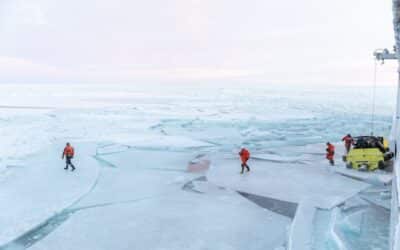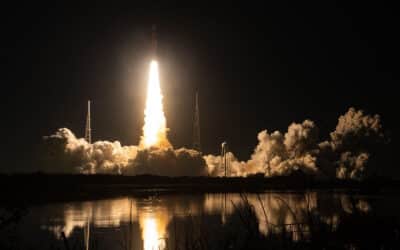The following blog was originally post to the CIEL web site as “We Do Not Need Geoengineering to Solve (or Exacerbate) the Climate Crisis“.
by Carroll Muffett
On February 13, the Center for International Environmental Law launched a major new report examining the repeated and ongoing instances in which fossil fuel companies played a disproportionate role in promotion of carbon capture and storage, carbon dioxide removal strategies, and other geoengineering techniques. As we expected it to do, the report sparked excitement among partners around the world, sparked debate in the geoengineering community, and drew the ire of a small but vocal minority of geoengineering proponents. CIEL is no stranger to publishing research that conflicts with vested interests. We undertake that research accordingly—working to ensure that it is rigorous, detailed, and well-documented. We expected—and indeed, welcome—critiques of our work that adhere to the same standards.
Unfortunately, not all of them do.
In a blog posted to Legal Planet on February 17, 2019, and again on Twitter in recent days, geoengineering advocate Jesse Reynolds has sought to discredit Fuel to the Fire as “misleading,” “wrong,” and “harmful.” Unfortunately for Reynolds, for his host institutions, and for the informed debate on geoengineering, Reynolds’ blog attempts to deconstruct a report that bears little resemblance to Fuel to the Fire. To advance his thesis, Reynolds ignores large parts of the analysis, mischaracterizes others, and ignores and grossly distorts the evidence CIEL has put forth.
As an organization committed not only to rigorous legal research and analysis but also to the education and training of the next generations of lawyers, CIEL is particularly troubled that Reynolds’ attack piece was published under the mastheads and implicit imprimatur of two of the most respected institutions for legal learning in the United States.
CIEL and Reynolds are in agreement that a small but growing number of environmentalists and scientists are now seriously considering the once unthinkable prospect of geoengineering due to legitimate concerns about the gravity of the climate crisis and the shrinking window of opportunity for meaningful action. Where we differ—significantly—is in our willingness to recognize, and acknowledge, that other, far less magnanimous forces have long shaped geoengineering debates and are continuing to do so.
Reynold’s principal source for arguing against industry influence in the debates over Carbon Dioxide Removal and Solar Radiation Modification is a four paragraph blurb in an opinion piece published by Reynolds himself in 2016. CIEL reviewed this OpEd in researching Fuel to the Fire but found it too lacking in substantive analysis or usable data to reference in our report. Reynolds’ recent and more direct attack on our work offers little by way of additional support for his thesis.
CIEL’s report focuses first and most heavily on carbon capture and storage, enhanced oil recovery, and related carbon dioxide removal technologies that have played the most prominent role in policy debates on geoengineering to date. This includes an extensive review of early research; past and current patent filings; ongoing and well-documented commercial interest of fossil fuel companies in these technologies; and the numerous ways in which carbon dioxide removal strategies will serve to extend and entrench a fossil-based economy. This last point is evidenced strongly by the dependence on CDR in the climate plans of the oil companies themselves, enabling continued heavy reliance on oil and gas for decades to come. Rather than engaging with this analysis, which constitutes the majority of the report, Reynolds simply says those issues are “complex.” We agree. They are also deeply relevant to the ongoing debates regarding geoengineering and integral to CIEL’s analysis.
Reynolds’ treatment of solar radiation management (SRM) is much more troubling. In lieu of addressing the evidence and analysis in CIEL’s report, Reynolds both grossly mischaracterizes CIEL’s central thesis and, more fundamentally, mischaracterizes the evidence in support of that thesis. In Fuel to the Fire, CIEL identifies numerous and repeated instances in which fossil fuel companies or researchers supported by fossil fuel interests worked to raise the profile of SRM as a solution to climate change. This includes not only authoring key workshop reports, but also convening critical meetings and funding ostensibly independent think tanks to promote geoengineering. The following is a list of indicative, though not exhaustive, examples that our report cites:
- SS Penner provided a key source for the 1992 National Academy of Science Panel’s discussion of strategic aerosol injection from aircraft at a time when his work was funded by and expressly designed to promote the fossil fuel industry.
- ExxonMobil’s Haroon Kheshgi and Brian Flannery authored important early articles on SRM and ocean geoengineering and were a consistent and active presence in geoengineering workshops until at least the mid-2000s.
- Lee Lane of the American Enterprise Institute (AEI) was a lead author on NASA’s SRM Workshop Report during a period in which AEI was heavily funded by ExxonMobil and actively engaged in climate denial campaigns. Both AEI’s SRM advocacy and ExxonMobil’s funding of AEI continued for years thereafter, including when Lane testified to the US Congress in support of SRM research.
- The influential Novim Climate Engineering Report was convened and led by Steve Koonin at a time when he was Chief Scientist at BP, and Steve Koonin continued to promote fossil fuel industry interests and climate denial through at least 2017.
- ExxonMobil was among the significant supporters of the Bipartisan Policy Center when they proposed geoengineering as a climate solution, and the oil industry was expressly referenced in contemporaneous new reports that BPC engaged in pay-to-play work for corporate donors.
- Climate denialist organizations and legislators (with well documented linkages to the fossil fuel industry and a history of opposition to climate action) have conducted ongoing advocacy on behalf of SRM.
With a single exception discussed below, Reynolds does not address these examples or the clear documentary evidence demonstrating the early and active role of the oil industry in weather modification research, including the patenting and promotion of technologies used in or remarkably similar to those promoted in geoengineering today. Nor does he address the repeated, explicit examples of prominent SRM advocates expressly arguing that SRM may be a cheaper alternative to emission reductions or may enable the delayed implementation of reduction measures.
In lieu of engaging with this evidence and the extensive and hyperlinked primary documentation upon which it is based, Reynolds fabricates a caricature of our analysis from just three quotes.
The first is a quote by Rex Tillerson of ExxonMobil, which is simply an epigraph to the report, and something others have used to highlight industry’s focus on technological fixes to climate change.
Reynolds then uses a single quote to argue that—notwithstanding direct and clearly contradictory evidence in the report—early work by researcher SS Penner did not endorse SRM as a cheaper alternative to reducing greenhouse emissions. Taken in its larger context, Penner was expressly advocating this view across two separate papers.
Finally, and regrettably, Reynolds takes a simple parenthetical about legendary climate researcher Wally Broecker and treats that parenthetical as indispensable to the report’s argument. It is not. An objective reading of the surrounding argument demonstrates that this was a simple aside provided for informational purposes only. Indeed, the accompanying endnote includes a direct quote from Broecker both acknowledging the funding referenced and expressing the view that it did not influence his research. Reynolds’ distortion of Fuel to the Fire in this way was particularly unfortunate in light of Broecker’s passing the following day.
Relying again on the blurb in his earlier OpEd, Reynolds then dismisses, without evidence, analysis, or meaningful argument, CIEL’s conclusion that climate denialists are now actively promoting geoengineering as an alternative to early and aggressive emission reductions. This last point is ironic given that, just days after the report was released, the Trump Administration appointed notorious climate denialist—and proponent of carbon removal technologies—William Happer to lead its “review” of climate science. In the intervening days, two other prominent climate denialists in the US Congress—Senators John Barasso and James Inhofe endorsed a bill that would promote carbon dioxide removal and direct air capture. Barasso, an author and lead sponsor of the bill, expressly promotes direct air capture and other technological fixes as an alternative to regulating CO2—precisely the concern raised in Fuel to the Fire.
Similarly, and more troublingly, Reynolds dismisses the discussion of geoengineering risks with the simple assertion, ipse dixit, that our discussion of those risks is, in some undefined way, “inaccurate.”
Reynolds’ remarks that this “misleading” report is unfortunate given CIEL’s valuable past work exposing fossil fuel industry efforts to confuse the discourse on climate change. We find this ironic; Steven Feit and myself are the investigators and authors on both of CIEL’s earlier Smoke & Fumes reports and Fuel to the Fire. Indeed, it was the documents, evidence, and relationships we unearthed during the Smoke & Fumesresearch that ultimately sparked and led to our work on geoengineering.
The promise of geoengineering in its varied forms is actively being used by those who support inaction. Fuel to the Fire documents numerous, significant, and ongoing instances of this. From CIEL’s perspective, this is not an abstract risk but a present reality. Taking into account the potential to delay meaningful solutions while creating new, significant, and as yet poorly understood risks for people across the world, CIEL concludes that SRM and SRM testing—like other forms of geoengineering—are more likely to accelerate and exacerbate the climate crisis than to help solve it.
As a final, if cursory, argument against CIEL’s work, Reynolds’ attributes our conclusions on geoengineering to the fact that both CIEL and the Heinrich Boell Foundation are “based in wealthy countries.” This is true. It is equally true that, for three decades, CIEL has worked with communities across the world living on the frontlines of the climate crisis to promote human rights and protect the environment. One of the recurring lessons from these three decades is that these communities are too frequently confronted by the adverse impacts of decisions taken in boardrooms and meeting halls thousands of miles away, and that the burden of proving the negative impacts of those decisions too often falls on those least equipped to do so. We have learned to listen to our partners on the ground, to respect their judgments about their own lands and lives, and to lend our support where we can.
This is why CIEL joined the Hands Off Mother Earth declaration in 2018. To date, the declaration has been signed by 180 organizations from six continents, more than two thirds of which are from the Global South. Its signatories include the Indigenous Environmental Network, the Third World Network, the World Indigenous Women’s Alliance, La Via Campesina, and winners of the Goldman Environment Prize and Right Livelihood Award from six countries. And, we are proud to say, it includes CIEL.
The Intergovernmental Panel on Climate Change’s 1.5°C report emphasized that the surest and safest way to stay below 1.5°C of warming is through the rapid and near complete phase out of fossil fuels. CIEL acknowledges that the window for achieving this is narrow and closing rapidly, and that the political will to achieve it does not yet exist. For reasons addressed at length in Part 7 of our report, however, we believe that making this transition is the only feasible and achievable pathway to meet the 1.5 target.
The science is clear that nothing short of a rapid and complete transformation of our energy system is needed to address climate change. The IPCC concluded that SRM was too uncertain and too risky to integrate into visions of our energy future. CIEL agrees.
By Carroll Muffett
CIEL President


